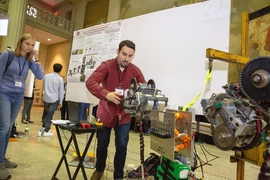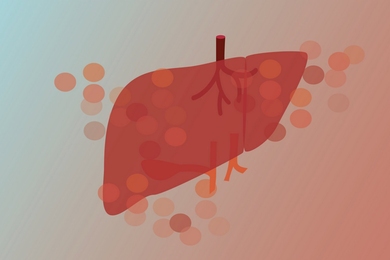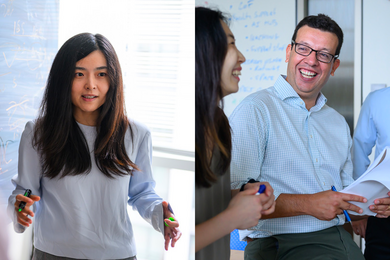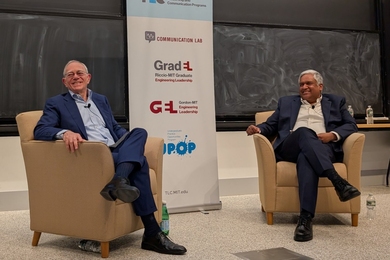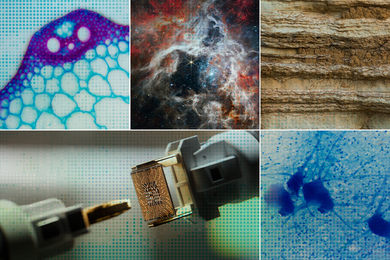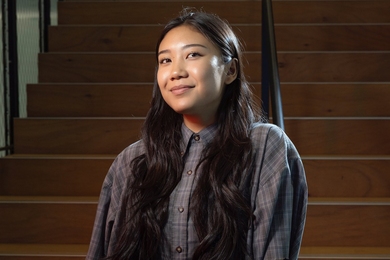One event has become a hallmark of nearly every academic conference: the poster session. Posters summarizing research are tacked onto endless rows of bulletin boards. Leaders in any given field meander through the posters, asking presenters questions about their work on the spot. For junior researchers participating in poster sessions for the first time, the events can be daunting.
The Graduate Association of Mechanical Engineers (GAME) and MIT’s Department of Mechanical Engineering are working to remove the intimidation factor that surrounds poster sessions and presentations. For the sixth year in a row, they have organized the Mechanical Engineering Research Exhibition (MERE), which was held on Oct. 11 in MIT’s student center. Over 60 graduate students, postdocs, and Undergraduate Research Opportunity Program (UROP) students presented their research projects to nearly 200 attendees in a poster session-style event. The event was organized by graduate students Crystal Owens and Maytee Chantharayukhonthorn.
“Providing students with a venue to practice presenting has been instrumental in boosting their confidence,” says Evelyn Wang, Gail E. Kendall Professor and department head in mechanical engineering. “Whether students pursue a career in academia, industry, or government, the ability to clearly communicate about their work will always be a crucial skill.”
Nicholas Fang, professor of mechanical engineering and GAME faculty advisor, has seen these skills of technical communication improve in students who participate in MERE year-to-year. He also sees the event as a great introduction to MIT for first-year graduate students and undergrads who are considering graduate study at MIT.
“Participation by first-year students is very important to this event,” he explains. “New students can’t take a seat in every single lab to learn about each other’s work, so MERE gives them the best opportunity to get to know the research in the department as a whole.”
Mechanical engineering research across MIT is incredibly diverse and touches upon a wide swath of disciplines, but one common theme united the research presented at MERE — every project offered solutions and insights that could one day have tangible impact on a global scale.
Solutions in human health
Two examples of projects that could impact human health took different approaches to improving our understanding of brain cancer. Cynthia Hajal is using microfluidic chips to grow blood vessels that mimic the human brain. A PhD candidate working with Roger Kamm, Cecil and Ida Green Distinguished Professor of Biological and Mechanical Engineering, Hajal is using microfluidics to learn more about how cancer metastasizes in the brain.
“The idea is to rebuild human organs outside of the body to track and test different diseases,” explains Hajal. To track and test brain cancer, Hajal and her team place cells taken from a human brain into microfluidic channels that are pumped with nutrients and serum. About seven days later, the cells self-assemble into brain capillaries. The research team then places tumor cells into the channels and tracks their progression over time.
“Our process helps us image metastasis in short intervals of time so we can really slow down and find out what exactly is happening at every stage of the process,” Hajal adds.
Ali Daher, meanwhile, uses mathematical modelling in the hopes of one day helping doctors determine the best course of treatment for glioblastoma multiforme brain tumors. “When a doctor is in the process of coming up with a treatment plan for the patient, they are faced with many challenges,” says Daher, a senior studying mechanical engineering.
To help inform a doctor’s treatment plan, Daher is utilizing mathematical models to predict how a tumor might react to treatment plans. Using a reduced-order scheme developed for fluid systems by Pierre Lermusiaux, professor of mechanical engineering, Daher worked on an algorithm that could help doctors determine what therapies would be most effective.
Improving access to food and water
In addition to human health, another pervasive theme at MERE this year was how humans interact with the environment. Two projects in particular honed in on how we can improve access to food and water, especially in developing countries.
Sonal Thengane, a postdoc working with Ahmed Ghoniem, the Ronald C. Crane (1972) Professor, is developing fertilizers made of carbon-rich biochar to improve soil quality and crop yield. Biochar is made by torrefying (drying with fire) waste from farms or forests. “When it is mixed into the soil, the biochar is very porous and retains the moisture and nutrients for a longer time,” says Thengane.
Thengane’s work has already been tested on a farm in Kenya and will soon be tested in the United States and India with support from the Abdul Latif Jameel World Water and Food Security Lab (J-WAFS). He and his team have also explored the possibility of repurposing the debris from forest fires and logging residues, and using it in biochar-based soil. “We are also working in California, which has had so many forest fires recently,” he explains. “California has many farms that could benefit from this soil.”
While Thengane is working on improving crop yield and increasing access to safer food, Hannah Varner is hoping to improve access to fresh water in India. A graduate student in MIT’s GEAR Lab, Varner is in the process of building a prototype system that desalinates brackish water in India.
“Groundwater holds a lot of potential for solving the water crisis in places like India and the southwestern United States,” says Varner, who works with Associate Professor Amos Winter. The problem with groundwater is it often is brackish — containing too much salt to be potable. Utilizing modeling and an understanding of fluid dynamics and electrochemical processes, Varner was able to design a system for point-of-use desalination of brackish water in India.
“The really exciting thing is I was able to design a system and then bring it to Bangalore this summer,” she says.
Award winners
Throughout MERE, participants like Varner spoke with judges who assessed their presentation skills. Awards were given to the following students:
First-place presentations: Erin Looney for “Accelerating Cleantech Hardware System Development;” John San Soucie for “Gaussian dirichlet Random Fields For Inference Over High Dimensional Categorical Observations;” Nick Selby for “Teachbot : An Education System For Workforce;” and Meghan Huber for “Visual Perception Of Stiffness From Multijoint Motion”
Best first-time presenter: Kuangye Lu for “Remote Epitaxy Of Gaas On Cvd Graphene For Wafer Re Usability And Flexible Electronics”
Best UROP: Helen Read for “Fracture Toughness Of Polyacrylamide Hydrogels”
Second-place runners-up include: Chinmay Kulkarni, Cynthia Hajal, Jongwoo Lee, Francesco Sigorato and Matteo Alberghini, Kiarash Gordiz, Nisha Chandramoorthy, Noam Buckman, Emily Rogers, and Sydney Sroka.
The following presenters were given honorable mentions: James Hermus, Yeongin Kim, ZhiYi Liang, Lauren Chai, Sanghoon Bae, Antoine Blanchard, Rabab Haider, Scott Tan, and Jaewoo Shim.
Making your own luck
After the conclusion of the exhibition, Helen Greiner '89, SM '90 delivered a keynote speech. An innovator in the field of robotics, Greiner traced her career path in front of an audience filled with mechanical engineering students. Inspired by the Star Wars character R2D2, Greiner took an early interest in robotics. In 1990, she co-founded iRobot.
After a decade of trial and error, iRobot found success with products such as the Roomba and PackBot. While the Roomba has cemented its place in popular culture, thanks in large part to a Pepsi advertisement featuring Dave Chappelle, the PackBot has made a huge impact on how military operations are executed.
“These robots were credited with saving the lives of hundreds of soldiers and thousands of civilians,” Greiner recalls.
Greiner encouraged students to “make their own luck.” With luck and determination, the students and postdocs who presented earlier in the day could someday see their products, designs, and theories have the kind of impact Greiner’s robot innovations have had.





